MAR7510-B Consumer Behavior Report: Tea Market Analysis
VerifiedAdded on 2023/06/10
|16
|4548
|163
Report
AI Summary
This report provides a comprehensive analysis of consumer behavior in the context of tea purchases. It begins with an executive summary and an introduction, outlining the factors influencing consumer decisions. The report identifies the targeted customers for tea, segmented by demographics, and behavioral and psychographic characteristics. It then delves into the decision-making forces, differentiating between external (social and cultural) and internal (personal and psychological) influences. Consumer involvement and risks associated with tea purchases are assessed, followed by an examination of the value consumers derive from tea, including health benefits and cost-effectiveness. The core of the report analyzes the decision-making and buying process, from problem recognition to post-purchase behavior. It also identifies situational factors impacting consumer behavior, such as condition, location, mood, time, and social situations. Key consumer behavior theories are connected to marketing strategies. The report further explores marketing research methods, social media insights, and key consumer insights. The conclusion summarizes the findings and references the sources used.
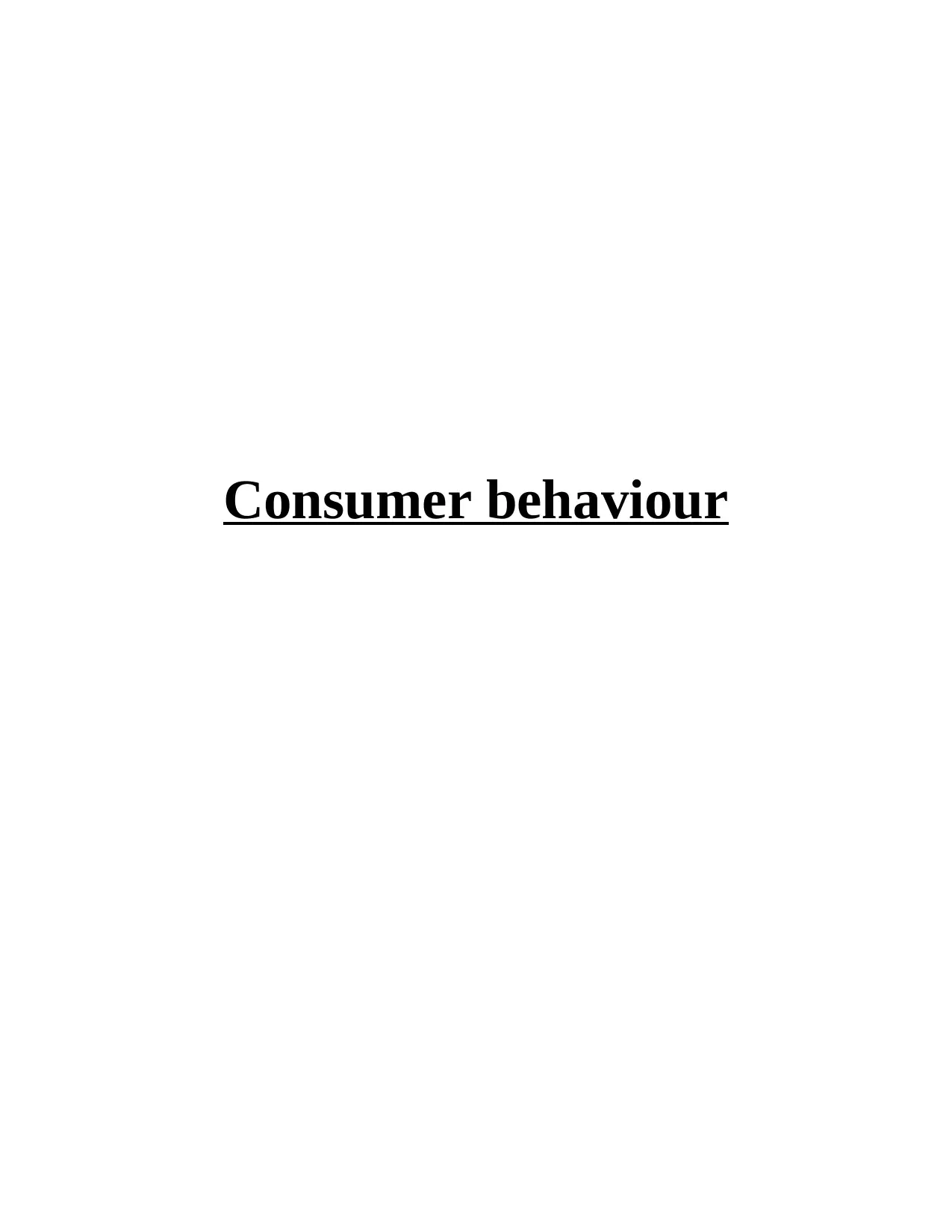
Consumer behaviour
Secure Best Marks with AI Grader
Need help grading? Try our AI Grader for instant feedback on your assignments.
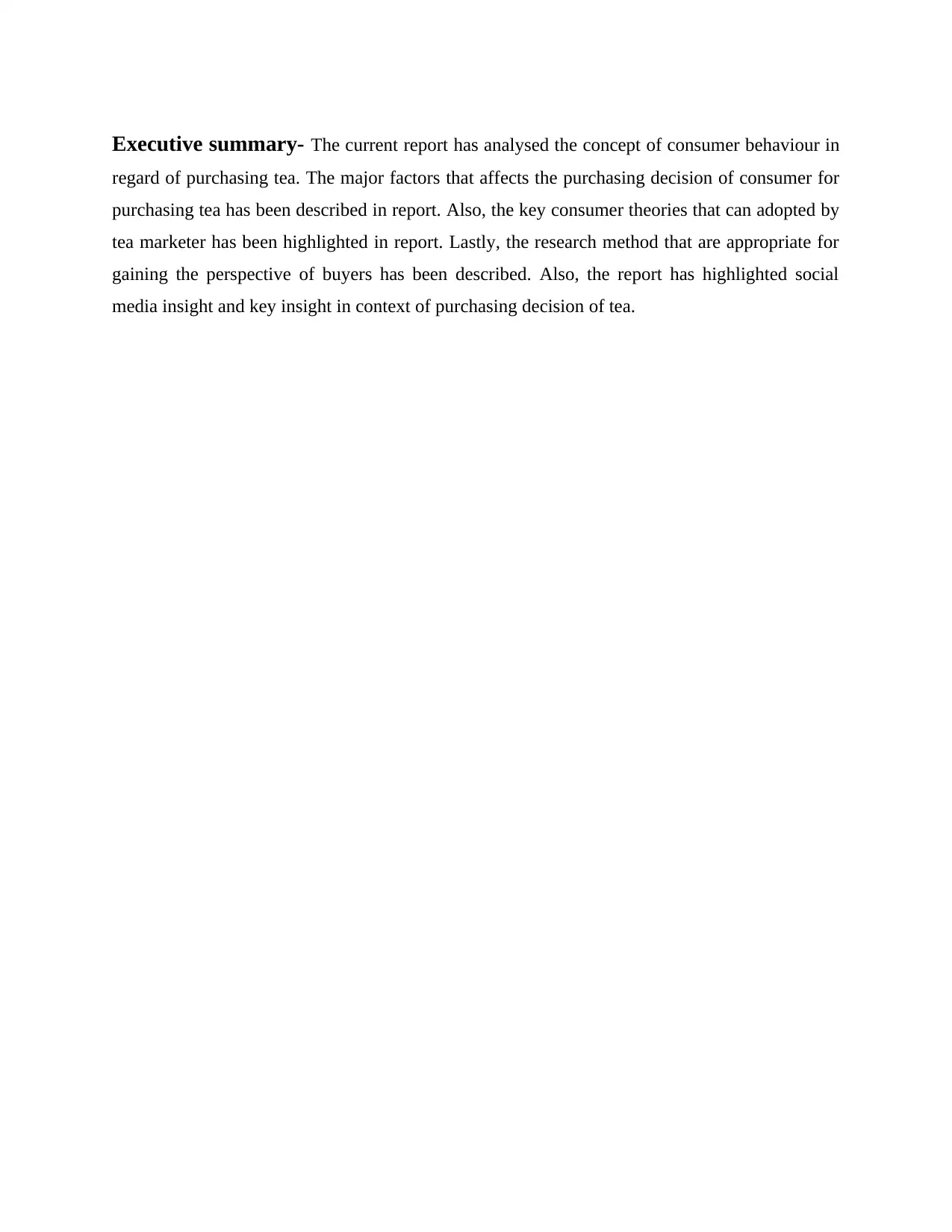
Executive summary- The current report has analysed the concept of consumer behaviour in
regard of purchasing tea. The major factors that affects the purchasing decision of consumer for
purchasing tea has been described in report. Also, the key consumer theories that can adopted by
tea marketer has been highlighted in report. Lastly, the research method that are appropriate for
gaining the perspective of buyers has been described. Also, the report has highlighted social
media insight and key insight in context of purchasing decision of tea.
regard of purchasing tea. The major factors that affects the purchasing decision of consumer for
purchasing tea has been described in report. Also, the key consumer theories that can adopted by
tea marketer has been highlighted in report. Lastly, the research method that are appropriate for
gaining the perspective of buyers has been described. Also, the report has highlighted social
media insight and key insight in context of purchasing decision of tea.
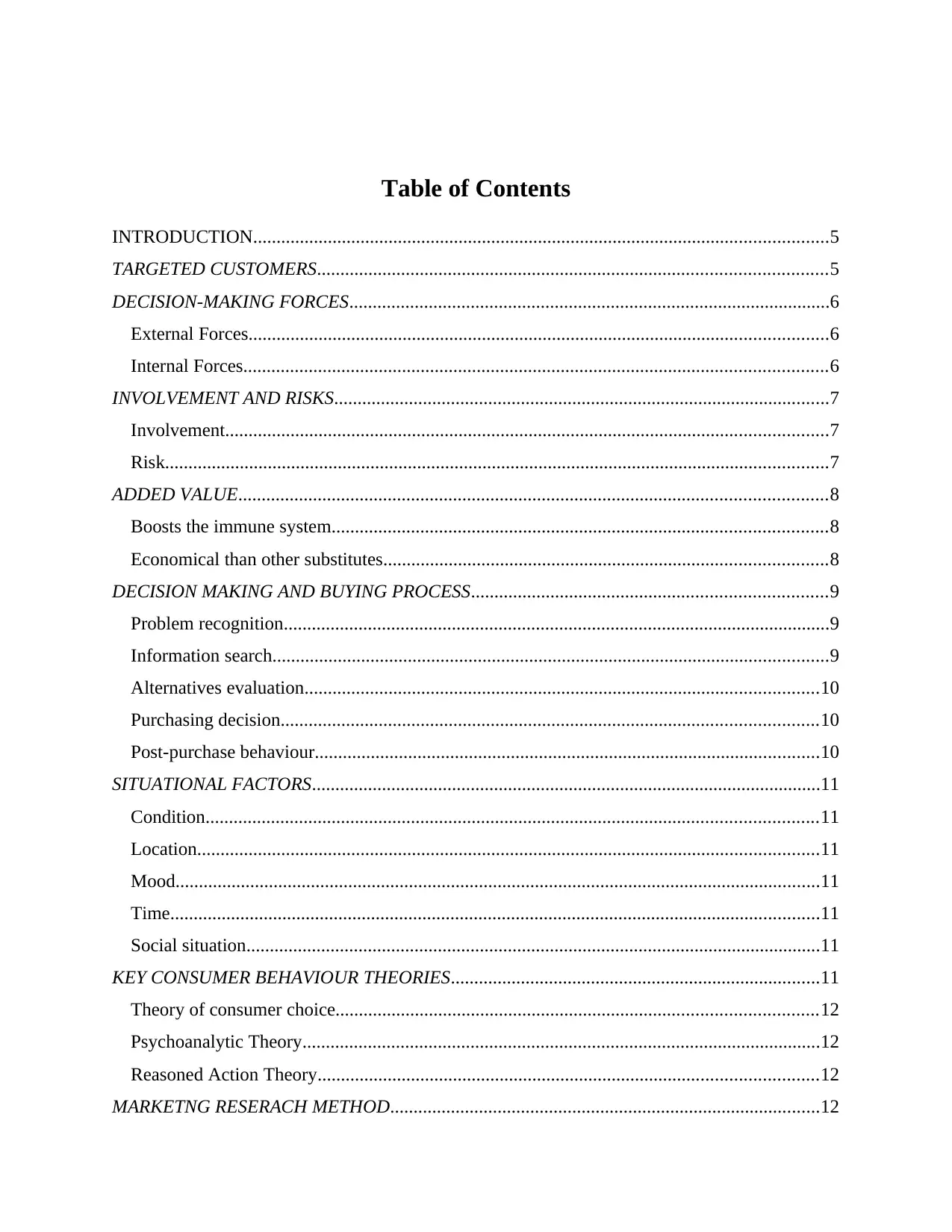
Table of Contents
INTRODUCTION...........................................................................................................................5
TARGETED CUSTOMERS.............................................................................................................5
DECISION-MAKING FORCES.......................................................................................................6
External Forces............................................................................................................................6
Internal Forces.............................................................................................................................6
INVOLVEMENT AND RISKS..........................................................................................................7
Involvement.................................................................................................................................7
Risk..............................................................................................................................................7
ADDED VALUE..............................................................................................................................8
Boosts the immune system..........................................................................................................8
Economical than other substitutes...............................................................................................8
DECISION MAKING AND BUYING PROCESS............................................................................9
Problem recognition.....................................................................................................................9
Information search.......................................................................................................................9
Alternatives evaluation..............................................................................................................10
Purchasing decision...................................................................................................................10
Post-purchase behaviour............................................................................................................10
SITUATIONAL FACTORS.............................................................................................................11
Condition...................................................................................................................................11
Location.....................................................................................................................................11
Mood..........................................................................................................................................11
Time...........................................................................................................................................11
Social situation...........................................................................................................................11
KEY CONSUMER BEHAVIOUR THEORIES...............................................................................11
Theory of consumer choice.......................................................................................................12
Psychoanalytic Theory...............................................................................................................12
Reasoned Action Theory...........................................................................................................12
MARKETNG RESERACH METHOD............................................................................................12
INTRODUCTION...........................................................................................................................5
TARGETED CUSTOMERS.............................................................................................................5
DECISION-MAKING FORCES.......................................................................................................6
External Forces............................................................................................................................6
Internal Forces.............................................................................................................................6
INVOLVEMENT AND RISKS..........................................................................................................7
Involvement.................................................................................................................................7
Risk..............................................................................................................................................7
ADDED VALUE..............................................................................................................................8
Boosts the immune system..........................................................................................................8
Economical than other substitutes...............................................................................................8
DECISION MAKING AND BUYING PROCESS............................................................................9
Problem recognition.....................................................................................................................9
Information search.......................................................................................................................9
Alternatives evaluation..............................................................................................................10
Purchasing decision...................................................................................................................10
Post-purchase behaviour............................................................................................................10
SITUATIONAL FACTORS.............................................................................................................11
Condition...................................................................................................................................11
Location.....................................................................................................................................11
Mood..........................................................................................................................................11
Time...........................................................................................................................................11
Social situation...........................................................................................................................11
KEY CONSUMER BEHAVIOUR THEORIES...............................................................................11
Theory of consumer choice.......................................................................................................12
Psychoanalytic Theory...............................................................................................................12
Reasoned Action Theory...........................................................................................................12
MARKETNG RESERACH METHOD............................................................................................12
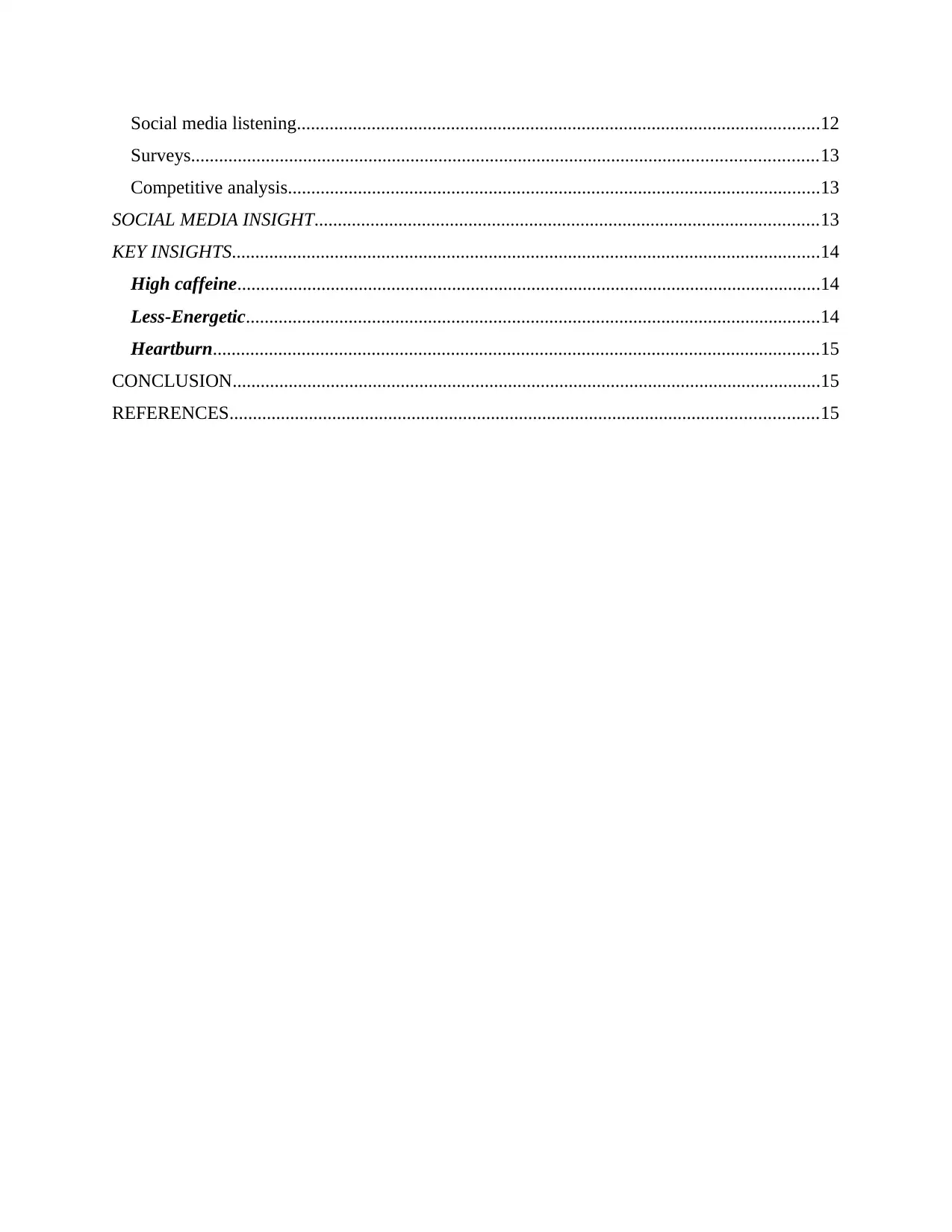
Social media listening................................................................................................................12
Surveys......................................................................................................................................13
Competitive analysis..................................................................................................................13
SOCIAL MEDIA INSIGHT............................................................................................................13
KEY INSIGHTS..............................................................................................................................14
High caffeine.............................................................................................................................14
Less-Energetic...........................................................................................................................14
Heartburn..................................................................................................................................15
CONCLUSION..............................................................................................................................15
REFERENCES..............................................................................................................................15
Surveys......................................................................................................................................13
Competitive analysis..................................................................................................................13
SOCIAL MEDIA INSIGHT............................................................................................................13
KEY INSIGHTS..............................................................................................................................14
High caffeine.............................................................................................................................14
Less-Energetic...........................................................................................................................14
Heartburn..................................................................................................................................15
CONCLUSION..............................................................................................................................15
REFERENCES..............................................................................................................................15
Secure Best Marks with AI Grader
Need help grading? Try our AI Grader for instant feedback on your assignments.
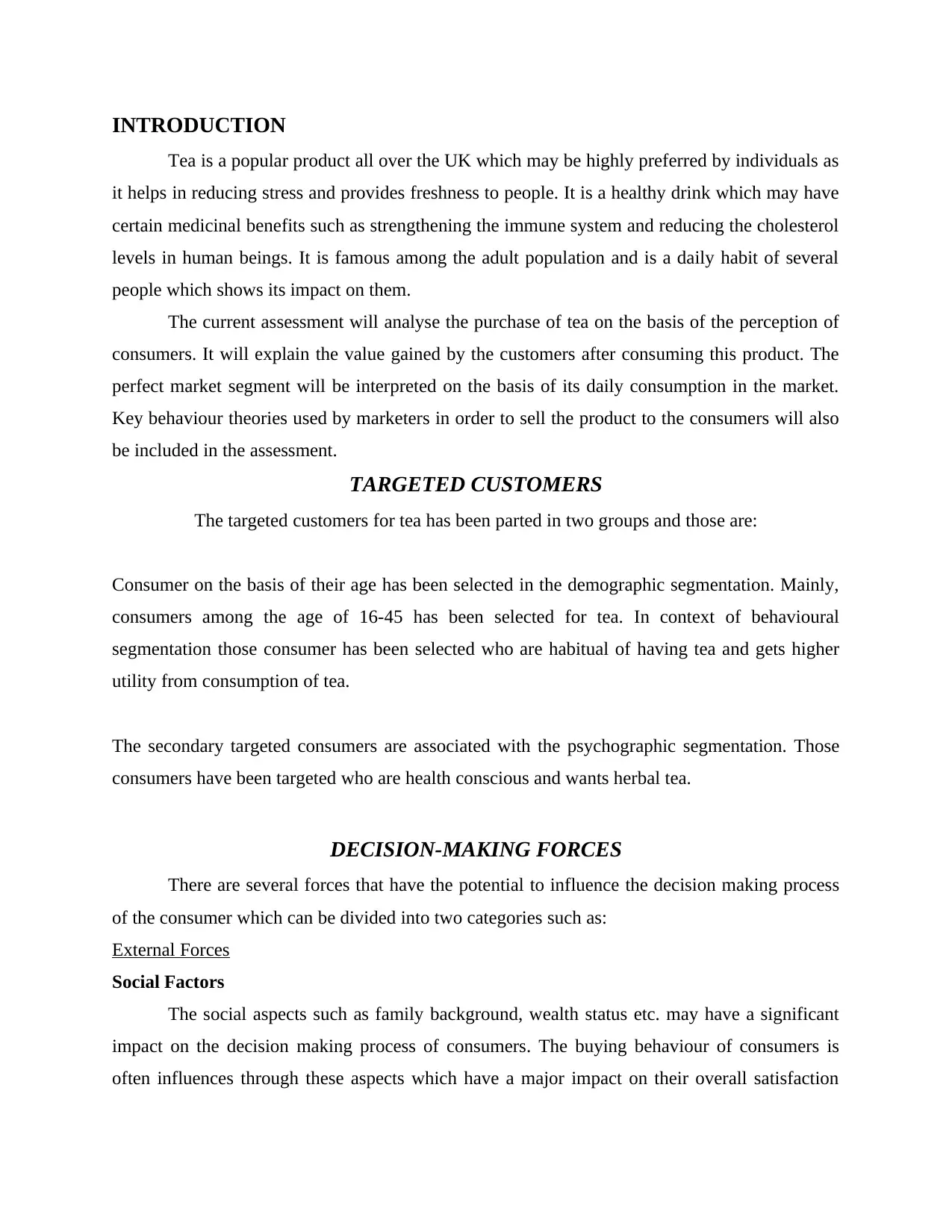
INTRODUCTION
Tea is a popular product all over the UK which may be highly preferred by individuals as
it helps in reducing stress and provides freshness to people. It is a healthy drink which may have
certain medicinal benefits such as strengthening the immune system and reducing the cholesterol
levels in human beings. It is famous among the adult population and is a daily habit of several
people which shows its impact on them.
The current assessment will analyse the purchase of tea on the basis of the perception of
consumers. It will explain the value gained by the customers after consuming this product. The
perfect market segment will be interpreted on the basis of its daily consumption in the market.
Key behaviour theories used by marketers in order to sell the product to the consumers will also
be included in the assessment.
TARGETED CUSTOMERS
The targeted customers for tea has been parted in two groups and those are:
Consumer on the basis of their age has been selected in the demographic segmentation. Mainly,
consumers among the age of 16-45 has been selected for tea. In context of behavioural
segmentation those consumer has been selected who are habitual of having tea and gets higher
utility from consumption of tea.
The secondary targeted consumers are associated with the psychographic segmentation. Those
consumers have been targeted who are health conscious and wants herbal tea.
DECISION-MAKING FORCES
There are several forces that have the potential to influence the decision making process
of the consumer which can be divided into two categories such as:
External Forces
Social Factors
The social aspects such as family background, wealth status etc. may have a significant
impact on the decision making process of consumers. The buying behaviour of consumers is
often influences through these aspects which have a major impact on their overall satisfaction
Tea is a popular product all over the UK which may be highly preferred by individuals as
it helps in reducing stress and provides freshness to people. It is a healthy drink which may have
certain medicinal benefits such as strengthening the immune system and reducing the cholesterol
levels in human beings. It is famous among the adult population and is a daily habit of several
people which shows its impact on them.
The current assessment will analyse the purchase of tea on the basis of the perception of
consumers. It will explain the value gained by the customers after consuming this product. The
perfect market segment will be interpreted on the basis of its daily consumption in the market.
Key behaviour theories used by marketers in order to sell the product to the consumers will also
be included in the assessment.
TARGETED CUSTOMERS
The targeted customers for tea has been parted in two groups and those are:
Consumer on the basis of their age has been selected in the demographic segmentation. Mainly,
consumers among the age of 16-45 has been selected for tea. In context of behavioural
segmentation those consumer has been selected who are habitual of having tea and gets higher
utility from consumption of tea.
The secondary targeted consumers are associated with the psychographic segmentation. Those
consumers have been targeted who are health conscious and wants herbal tea.
DECISION-MAKING FORCES
There are several forces that have the potential to influence the decision making process
of the consumer which can be divided into two categories such as:
External Forces
Social Factors
The social aspects such as family background, wealth status etc. may have a significant
impact on the decision making process of consumers. The buying behaviour of consumers is
often influences through these aspects which have a major impact on their overall satisfaction
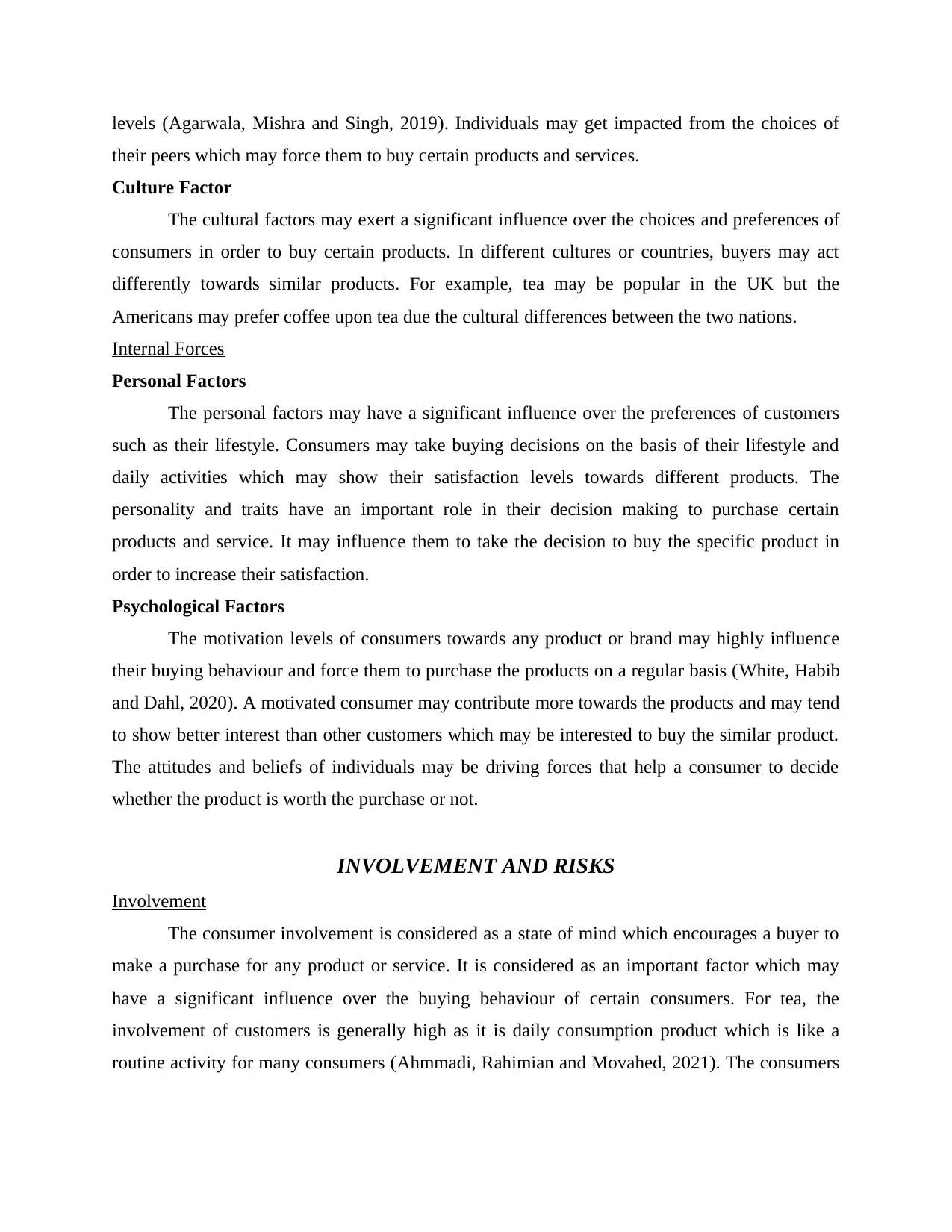
levels (Agarwala, Mishra and Singh, 2019). Individuals may get impacted from the choices of
their peers which may force them to buy certain products and services.
Culture Factor
The cultural factors may exert a significant influence over the choices and preferences of
consumers in order to buy certain products. In different cultures or countries, buyers may act
differently towards similar products. For example, tea may be popular in the UK but the
Americans may prefer coffee upon tea due the cultural differences between the two nations.
Internal Forces
Personal Factors
The personal factors may have a significant influence over the preferences of customers
such as their lifestyle. Consumers may take buying decisions on the basis of their lifestyle and
daily activities which may show their satisfaction levels towards different products. The
personality and traits have an important role in their decision making to purchase certain
products and service. It may influence them to take the decision to buy the specific product in
order to increase their satisfaction.
Psychological Factors
The motivation levels of consumers towards any product or brand may highly influence
their buying behaviour and force them to purchase the products on a regular basis (White, Habib
and Dahl, 2020). A motivated consumer may contribute more towards the products and may tend
to show better interest than other customers which may be interested to buy the similar product.
The attitudes and beliefs of individuals may be driving forces that help a consumer to decide
whether the product is worth the purchase or not.
INVOLVEMENT AND RISKS
Involvement
The consumer involvement is considered as a state of mind which encourages a buyer to
make a purchase for any product or service. It is considered as an important factor which may
have a significant influence over the buying behaviour of certain consumers. For tea, the
involvement of customers is generally high as it is daily consumption product which is like a
routine activity for many consumers (Ahmmadi, Rahimian and Movahed, 2021). The consumers
their peers which may force them to buy certain products and services.
Culture Factor
The cultural factors may exert a significant influence over the choices and preferences of
consumers in order to buy certain products. In different cultures or countries, buyers may act
differently towards similar products. For example, tea may be popular in the UK but the
Americans may prefer coffee upon tea due the cultural differences between the two nations.
Internal Forces
Personal Factors
The personal factors may have a significant influence over the preferences of customers
such as their lifestyle. Consumers may take buying decisions on the basis of their lifestyle and
daily activities which may show their satisfaction levels towards different products. The
personality and traits have an important role in their decision making to purchase certain
products and service. It may influence them to take the decision to buy the specific product in
order to increase their satisfaction.
Psychological Factors
The motivation levels of consumers towards any product or brand may highly influence
their buying behaviour and force them to purchase the products on a regular basis (White, Habib
and Dahl, 2020). A motivated consumer may contribute more towards the products and may tend
to show better interest than other customers which may be interested to buy the similar product.
The attitudes and beliefs of individuals may be driving forces that help a consumer to decide
whether the product is worth the purchase or not.
INVOLVEMENT AND RISKS
Involvement
The consumer involvement is considered as a state of mind which encourages a buyer to
make a purchase for any product or service. It is considered as an important factor which may
have a significant influence over the buying behaviour of certain consumers. For tea, the
involvement of customers is generally high as it is daily consumption product which is like a
routine activity for many consumers (Ahmmadi, Rahimian and Movahed, 2021). The consumers
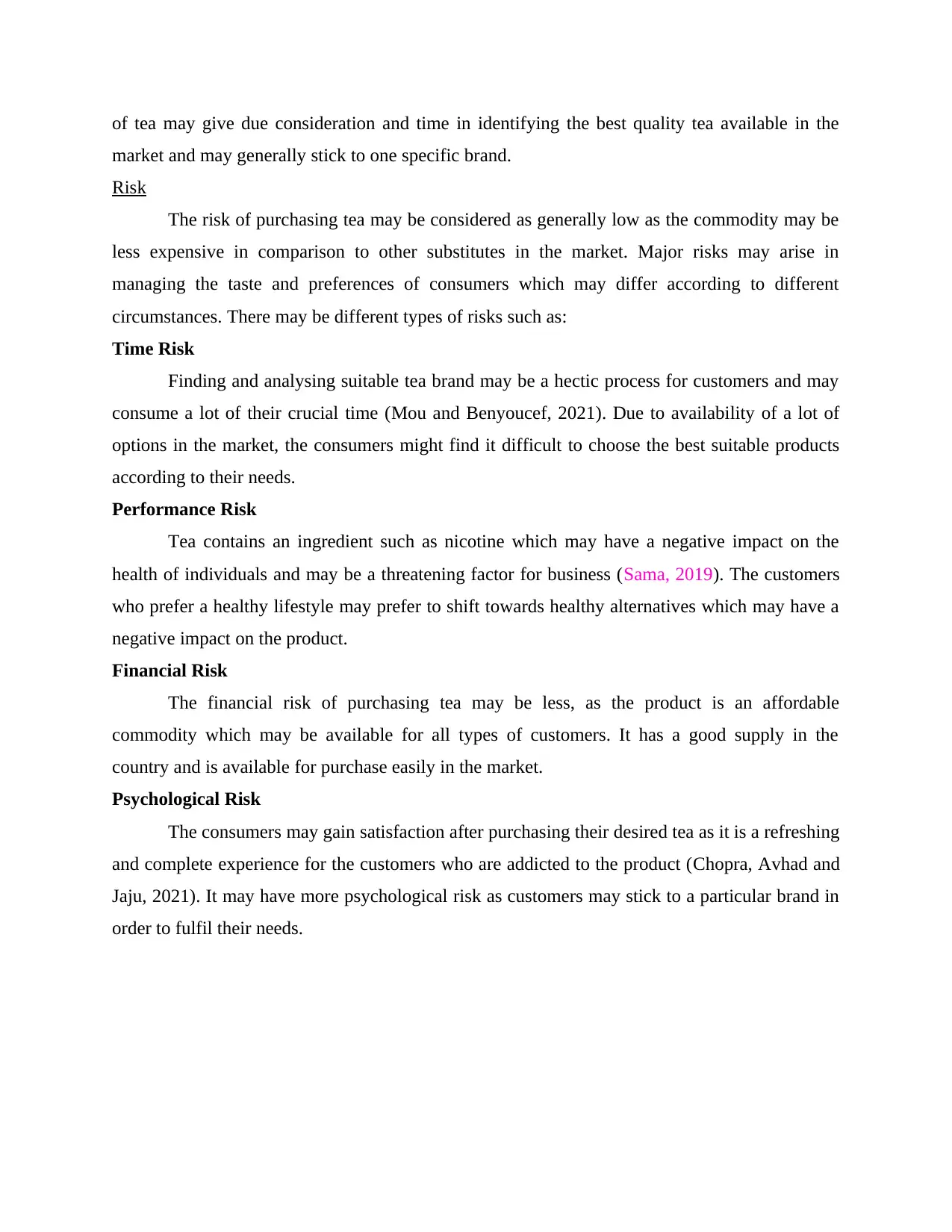
of tea may give due consideration and time in identifying the best quality tea available in the
market and may generally stick to one specific brand.
Risk
The risk of purchasing tea may be considered as generally low as the commodity may be
less expensive in comparison to other substitutes in the market. Major risks may arise in
managing the taste and preferences of consumers which may differ according to different
circumstances. There may be different types of risks such as:
Time Risk
Finding and analysing suitable tea brand may be a hectic process for customers and may
consume a lot of their crucial time (Mou and Benyoucef, 2021). Due to availability of a lot of
options in the market, the consumers might find it difficult to choose the best suitable products
according to their needs.
Performance Risk
Tea contains an ingredient such as nicotine which may have a negative impact on the
health of individuals and may be a threatening factor for business (Sama, 2019). The customers
who prefer a healthy lifestyle may prefer to shift towards healthy alternatives which may have a
negative impact on the product.
Financial Risk
The financial risk of purchasing tea may be less, as the product is an affordable
commodity which may be available for all types of customers. It has a good supply in the
country and is available for purchase easily in the market.
Psychological Risk
The consumers may gain satisfaction after purchasing their desired tea as it is a refreshing
and complete experience for the customers who are addicted to the product (Chopra, Avhad and
Jaju, 2021). It may have more psychological risk as customers may stick to a particular brand in
order to fulfil their needs.
market and may generally stick to one specific brand.
Risk
The risk of purchasing tea may be considered as generally low as the commodity may be
less expensive in comparison to other substitutes in the market. Major risks may arise in
managing the taste and preferences of consumers which may differ according to different
circumstances. There may be different types of risks such as:
Time Risk
Finding and analysing suitable tea brand may be a hectic process for customers and may
consume a lot of their crucial time (Mou and Benyoucef, 2021). Due to availability of a lot of
options in the market, the consumers might find it difficult to choose the best suitable products
according to their needs.
Performance Risk
Tea contains an ingredient such as nicotine which may have a negative impact on the
health of individuals and may be a threatening factor for business (Sama, 2019). The customers
who prefer a healthy lifestyle may prefer to shift towards healthy alternatives which may have a
negative impact on the product.
Financial Risk
The financial risk of purchasing tea may be less, as the product is an affordable
commodity which may be available for all types of customers. It has a good supply in the
country and is available for purchase easily in the market.
Psychological Risk
The consumers may gain satisfaction after purchasing their desired tea as it is a refreshing
and complete experience for the customers who are addicted to the product (Chopra, Avhad and
Jaju, 2021). It may have more psychological risk as customers may stick to a particular brand in
order to fulfil their needs.
Paraphrase This Document
Need a fresh take? Get an instant paraphrase of this document with our AI Paraphraser
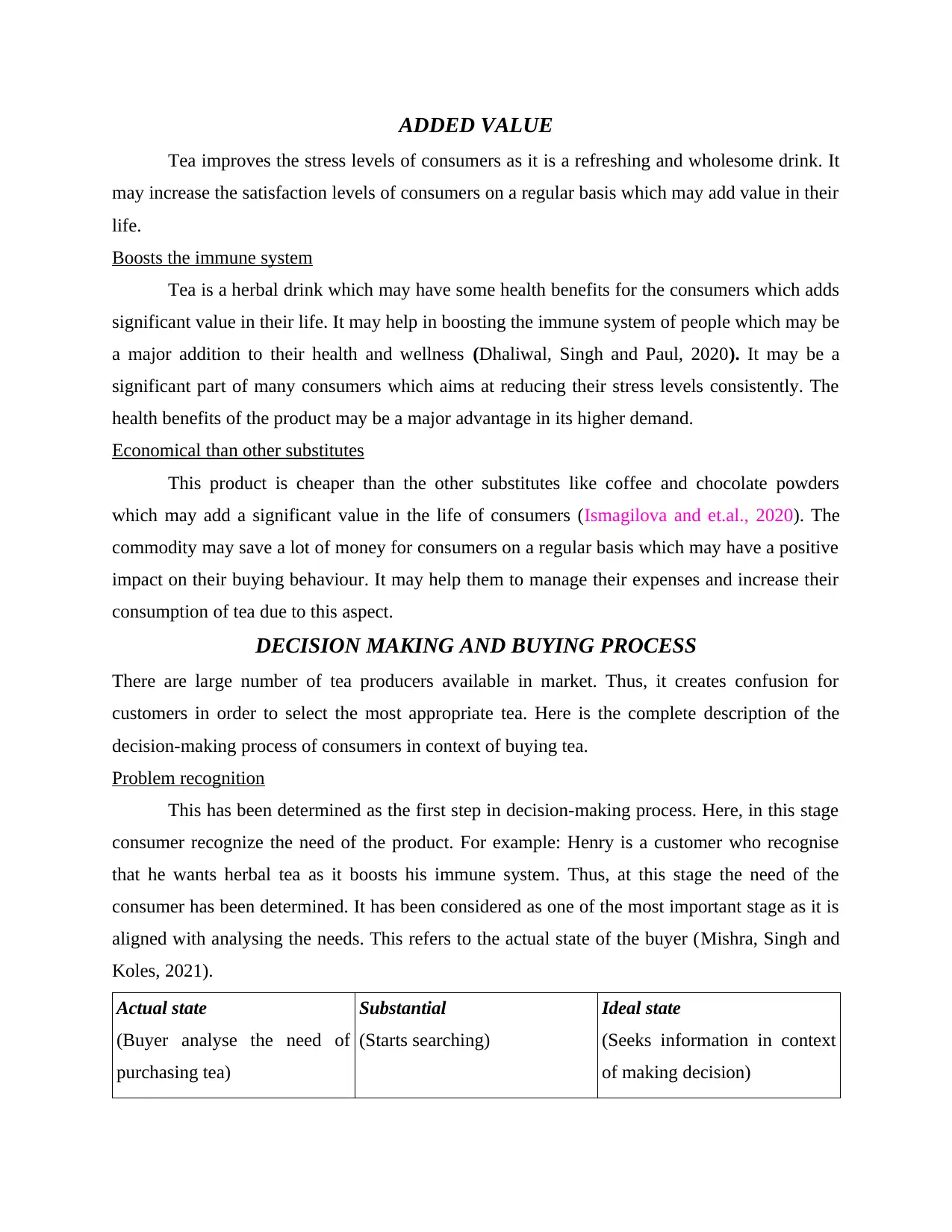
ADDED VALUE
Tea improves the stress levels of consumers as it is a refreshing and wholesome drink. It
may increase the satisfaction levels of consumers on a regular basis which may add value in their
life.
Boosts the immune system
Tea is a herbal drink which may have some health benefits for the consumers which adds
significant value in their life. It may help in boosting the immune system of people which may be
a major addition to their health and wellness (Dhaliwal, Singh and Paul, 2020). It may be a
significant part of many consumers which aims at reducing their stress levels consistently. The
health benefits of the product may be a major advantage in its higher demand.
Economical than other substitutes
This product is cheaper than the other substitutes like coffee and chocolate powders
which may add a significant value in the life of consumers (Ismagilova and et.al., 2020). The
commodity may save a lot of money for consumers on a regular basis which may have a positive
impact on their buying behaviour. It may help them to manage their expenses and increase their
consumption of tea due to this aspect.
DECISION MAKING AND BUYING PROCESS
There are large number of tea producers available in market. Thus, it creates confusion for
customers in order to select the most appropriate tea. Here is the complete description of the
decision-making process of consumers in context of buying tea.
Problem recognition
This has been determined as the first step in decision-making process. Here, in this stage
consumer recognize the need of the product. For example: Henry is a customer who recognise
that he wants herbal tea as it boosts his immune system. Thus, at this stage the need of the
consumer has been determined. It has been considered as one of the most important stage as it is
aligned with analysing the needs. This refers to the actual state of the buyer (Mishra, Singh and
Koles, 2021).
Actual state
(Buyer analyse the need of
purchasing tea)
Substantial
(Starts searching)
Ideal state
(Seeks information in context
of making decision)
Tea improves the stress levels of consumers as it is a refreshing and wholesome drink. It
may increase the satisfaction levels of consumers on a regular basis which may add value in their
life.
Boosts the immune system
Tea is a herbal drink which may have some health benefits for the consumers which adds
significant value in their life. It may help in boosting the immune system of people which may be
a major addition to their health and wellness (Dhaliwal, Singh and Paul, 2020). It may be a
significant part of many consumers which aims at reducing their stress levels consistently. The
health benefits of the product may be a major advantage in its higher demand.
Economical than other substitutes
This product is cheaper than the other substitutes like coffee and chocolate powders
which may add a significant value in the life of consumers (Ismagilova and et.al., 2020). The
commodity may save a lot of money for consumers on a regular basis which may have a positive
impact on their buying behaviour. It may help them to manage their expenses and increase their
consumption of tea due to this aspect.
DECISION MAKING AND BUYING PROCESS
There are large number of tea producers available in market. Thus, it creates confusion for
customers in order to select the most appropriate tea. Here is the complete description of the
decision-making process of consumers in context of buying tea.
Problem recognition
This has been determined as the first step in decision-making process. Here, in this stage
consumer recognize the need of the product. For example: Henry is a customer who recognise
that he wants herbal tea as it boosts his immune system. Thus, at this stage the need of the
consumer has been determined. It has been considered as one of the most important stage as it is
aligned with analysing the needs. This refers to the actual state of the buyer (Mishra, Singh and
Koles, 2021).
Actual state
(Buyer analyse the need of
purchasing tea)
Substantial
(Starts searching)
Ideal state
(Seeks information in context
of making decision)
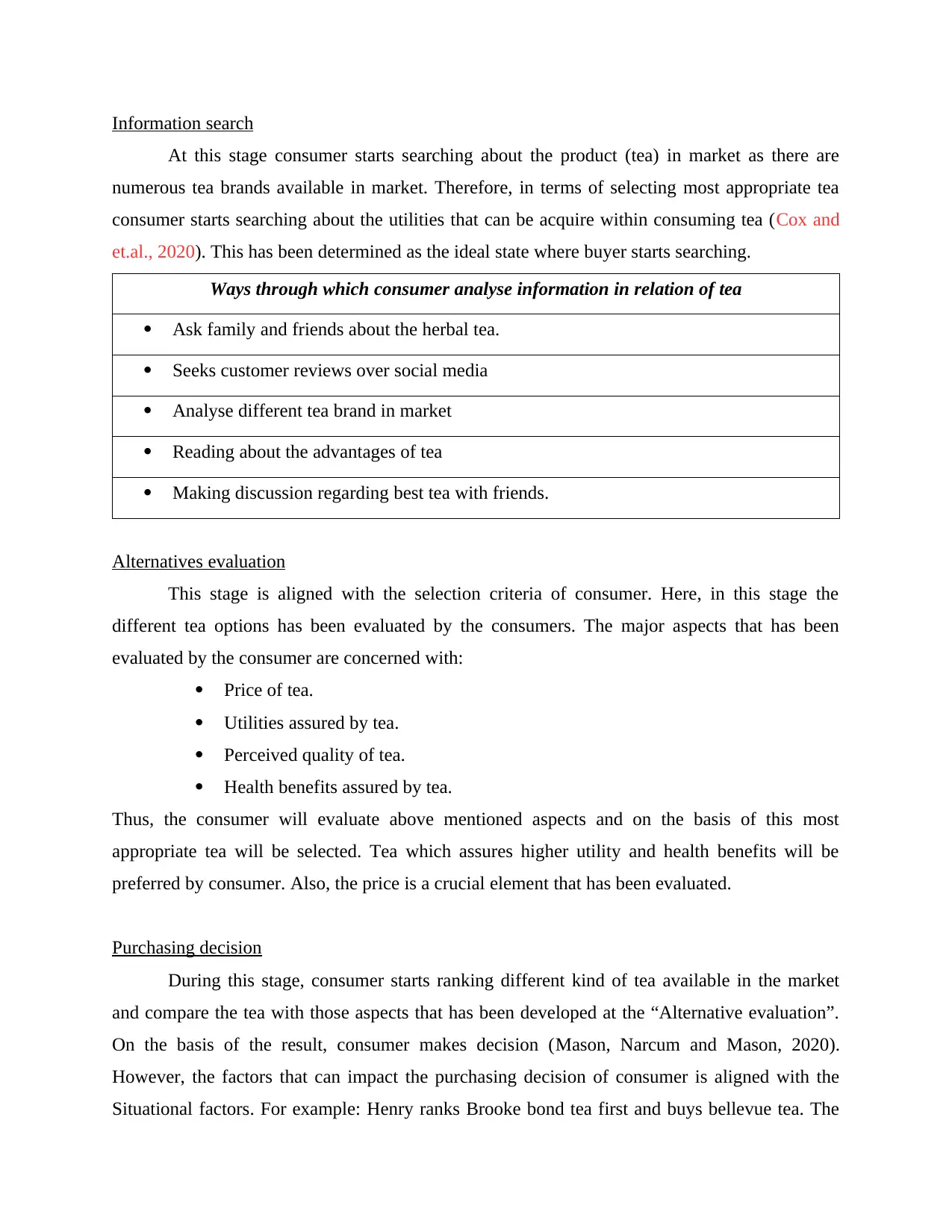
Information search
At this stage consumer starts searching about the product (tea) in market as there are
numerous tea brands available in market. Therefore, in terms of selecting most appropriate tea
consumer starts searching about the utilities that can be acquire within consuming tea (Cox and
et.al., 2020). This has been determined as the ideal state where buyer starts searching.
Ways through which consumer analyse information in relation of tea
Ask family and friends about the herbal tea.
Seeks customer reviews over social media
Analyse different tea brand in market
Reading about the advantages of tea
Making discussion regarding best tea with friends.
Alternatives evaluation
This stage is aligned with the selection criteria of consumer. Here, in this stage the
different tea options has been evaluated by the consumers. The major aspects that has been
evaluated by the consumer are concerned with:
Price of tea.
Utilities assured by tea.
Perceived quality of tea.
Health benefits assured by tea.
Thus, the consumer will evaluate above mentioned aspects and on the basis of this most
appropriate tea will be selected. Tea which assures higher utility and health benefits will be
preferred by consumer. Also, the price is a crucial element that has been evaluated.
Purchasing decision
During this stage, consumer starts ranking different kind of tea available in the market
and compare the tea with those aspects that has been developed at the “Alternative evaluation”.
On the basis of the result, consumer makes decision (Mason, Narcum and Mason, 2020).
However, the factors that can impact the purchasing decision of consumer is aligned with the
Situational factors. For example: Henry ranks Brooke bond tea first and buys bellevue tea. The
At this stage consumer starts searching about the product (tea) in market as there are
numerous tea brands available in market. Therefore, in terms of selecting most appropriate tea
consumer starts searching about the utilities that can be acquire within consuming tea (Cox and
et.al., 2020). This has been determined as the ideal state where buyer starts searching.
Ways through which consumer analyse information in relation of tea
Ask family and friends about the herbal tea.
Seeks customer reviews over social media
Analyse different tea brand in market
Reading about the advantages of tea
Making discussion regarding best tea with friends.
Alternatives evaluation
This stage is aligned with the selection criteria of consumer. Here, in this stage the
different tea options has been evaluated by the consumers. The major aspects that has been
evaluated by the consumer are concerned with:
Price of tea.
Utilities assured by tea.
Perceived quality of tea.
Health benefits assured by tea.
Thus, the consumer will evaluate above mentioned aspects and on the basis of this most
appropriate tea will be selected. Tea which assures higher utility and health benefits will be
preferred by consumer. Also, the price is a crucial element that has been evaluated.
Purchasing decision
During this stage, consumer starts ranking different kind of tea available in the market
and compare the tea with those aspects that has been developed at the “Alternative evaluation”.
On the basis of the result, consumer makes decision (Mason, Narcum and Mason, 2020).
However, the factors that can impact the purchasing decision of consumer is aligned with the
Situational factors. For example: Henry ranks Brooke bond tea first and buys bellevue tea. The
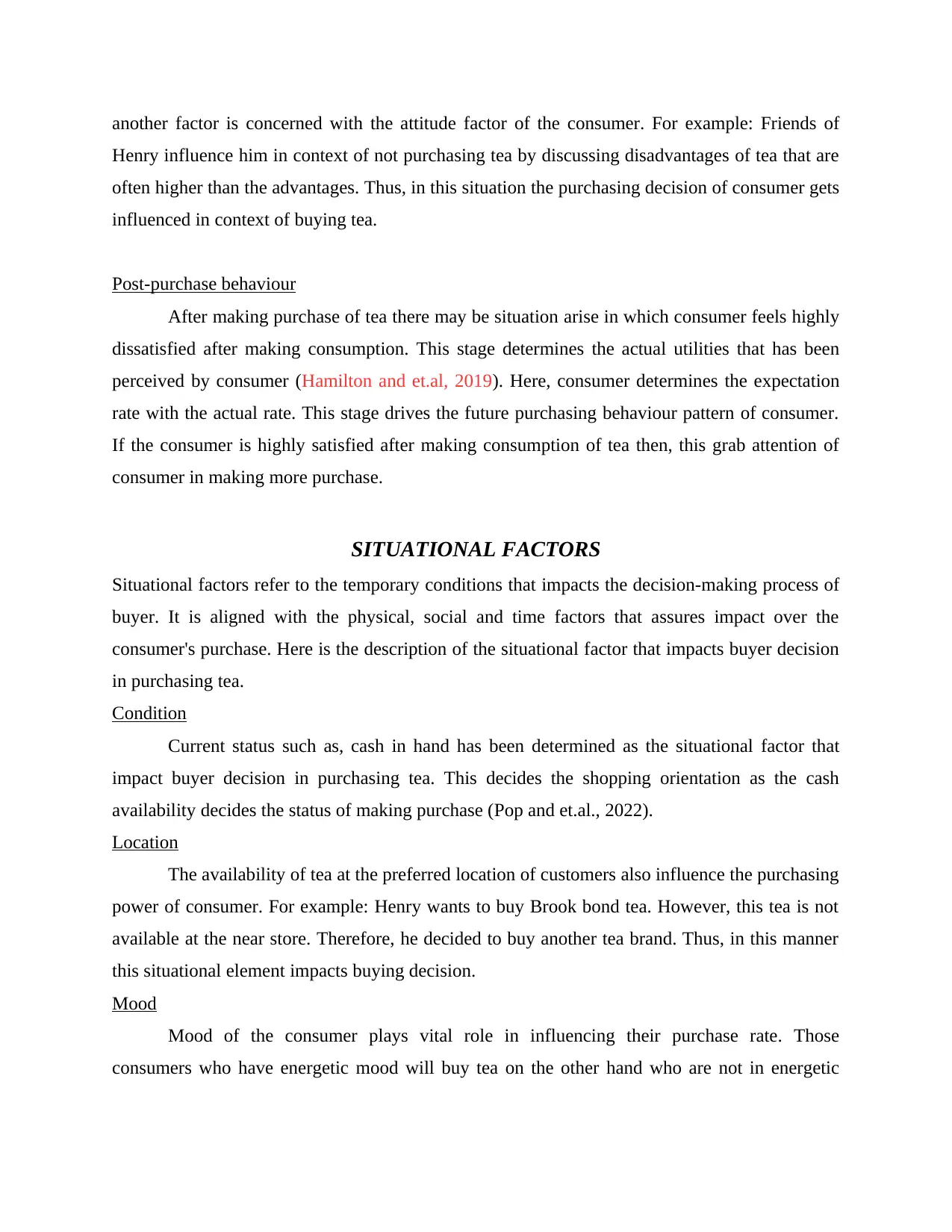
another factor is concerned with the attitude factor of the consumer. For example: Friends of
Henry influence him in context of not purchasing tea by discussing disadvantages of tea that are
often higher than the advantages. Thus, in this situation the purchasing decision of consumer gets
influenced in context of buying tea.
Post-purchase behaviour
After making purchase of tea there may be situation arise in which consumer feels highly
dissatisfied after making consumption. This stage determines the actual utilities that has been
perceived by consumer (Hamilton and et.al, 2019). Here, consumer determines the expectation
rate with the actual rate. This stage drives the future purchasing behaviour pattern of consumer.
If the consumer is highly satisfied after making consumption of tea then, this grab attention of
consumer in making more purchase.
SITUATIONAL FACTORS
Situational factors refer to the temporary conditions that impacts the decision-making process of
buyer. It is aligned with the physical, social and time factors that assures impact over the
consumer's purchase. Here is the description of the situational factor that impacts buyer decision
in purchasing tea.
Condition
Current status such as, cash in hand has been determined as the situational factor that
impact buyer decision in purchasing tea. This decides the shopping orientation as the cash
availability decides the status of making purchase (Pop and et.al., 2022).
Location
The availability of tea at the preferred location of customers also influence the purchasing
power of consumer. For example: Henry wants to buy Brook bond tea. However, this tea is not
available at the near store. Therefore, he decided to buy another tea brand. Thus, in this manner
this situational element impacts buying decision.
Mood
Mood of the consumer plays vital role in influencing their purchase rate. Those
consumers who have energetic mood will buy tea on the other hand who are not in energetic
Henry influence him in context of not purchasing tea by discussing disadvantages of tea that are
often higher than the advantages. Thus, in this situation the purchasing decision of consumer gets
influenced in context of buying tea.
Post-purchase behaviour
After making purchase of tea there may be situation arise in which consumer feels highly
dissatisfied after making consumption. This stage determines the actual utilities that has been
perceived by consumer (Hamilton and et.al, 2019). Here, consumer determines the expectation
rate with the actual rate. This stage drives the future purchasing behaviour pattern of consumer.
If the consumer is highly satisfied after making consumption of tea then, this grab attention of
consumer in making more purchase.
SITUATIONAL FACTORS
Situational factors refer to the temporary conditions that impacts the decision-making process of
buyer. It is aligned with the physical, social and time factors that assures impact over the
consumer's purchase. Here is the description of the situational factor that impacts buyer decision
in purchasing tea.
Condition
Current status such as, cash in hand has been determined as the situational factor that
impact buyer decision in purchasing tea. This decides the shopping orientation as the cash
availability decides the status of making purchase (Pop and et.al., 2022).
Location
The availability of tea at the preferred location of customers also influence the purchasing
power of consumer. For example: Henry wants to buy Brook bond tea. However, this tea is not
available at the near store. Therefore, he decided to buy another tea brand. Thus, in this manner
this situational element impacts buying decision.
Mood
Mood of the consumer plays vital role in influencing their purchase rate. Those
consumers who have energetic mood will buy tea on the other hand who are not in energetic
Secure Best Marks with AI Grader
Need help grading? Try our AI Grader for instant feedback on your assignments.
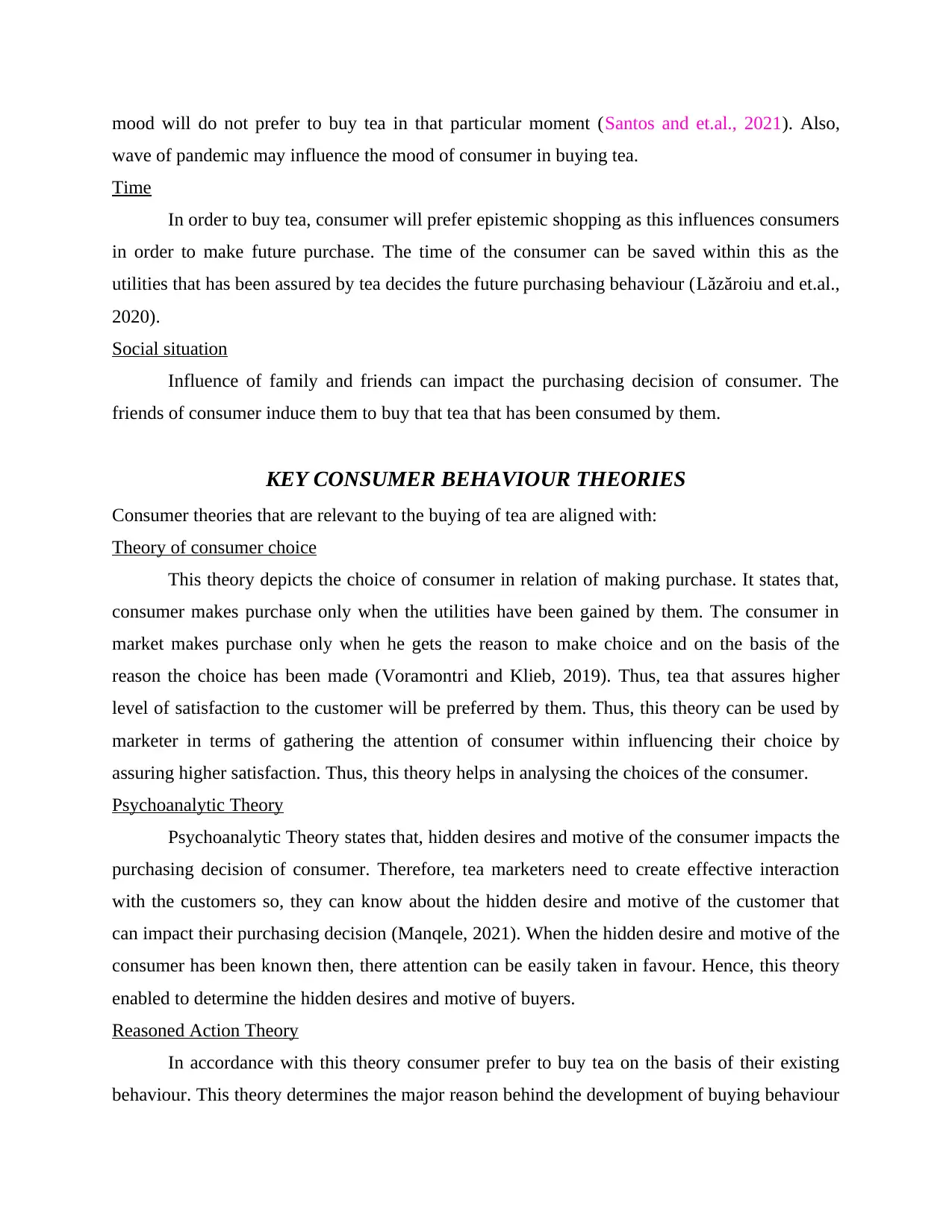
mood will do not prefer to buy tea in that particular moment (Santos and et.al., 2021). Also,
wave of pandemic may influence the mood of consumer in buying tea.
Time
In order to buy tea, consumer will prefer epistemic shopping as this influences consumers
in order to make future purchase. The time of the consumer can be saved within this as the
utilities that has been assured by tea decides the future purchasing behaviour (Lăzăroiu and et.al.,
2020).
Social situation
Influence of family and friends can impact the purchasing decision of consumer. The
friends of consumer induce them to buy that tea that has been consumed by them.
KEY CONSUMER BEHAVIOUR THEORIES
Consumer theories that are relevant to the buying of tea are aligned with:
Theory of consumer choice
This theory depicts the choice of consumer in relation of making purchase. It states that,
consumer makes purchase only when the utilities have been gained by them. The consumer in
market makes purchase only when he gets the reason to make choice and on the basis of the
reason the choice has been made (Voramontri and Klieb, 2019). Thus, tea that assures higher
level of satisfaction to the customer will be preferred by them. Thus, this theory can be used by
marketer in terms of gathering the attention of consumer within influencing their choice by
assuring higher satisfaction. Thus, this theory helps in analysing the choices of the consumer.
Psychoanalytic Theory
Psychoanalytic Theory states that, hidden desires and motive of the consumer impacts the
purchasing decision of consumer. Therefore, tea marketers need to create effective interaction
with the customers so, they can know about the hidden desire and motive of the customer that
can impact their purchasing decision (Manqele, 2021). When the hidden desire and motive of the
consumer has been known then, there attention can be easily taken in favour. Hence, this theory
enabled to determine the hidden desires and motive of buyers.
Reasoned Action Theory
In accordance with this theory consumer prefer to buy tea on the basis of their existing
behaviour. This theory determines the major reason behind the development of buying behaviour
wave of pandemic may influence the mood of consumer in buying tea.
Time
In order to buy tea, consumer will prefer epistemic shopping as this influences consumers
in order to make future purchase. The time of the consumer can be saved within this as the
utilities that has been assured by tea decides the future purchasing behaviour (Lăzăroiu and et.al.,
2020).
Social situation
Influence of family and friends can impact the purchasing decision of consumer. The
friends of consumer induce them to buy that tea that has been consumed by them.
KEY CONSUMER BEHAVIOUR THEORIES
Consumer theories that are relevant to the buying of tea are aligned with:
Theory of consumer choice
This theory depicts the choice of consumer in relation of making purchase. It states that,
consumer makes purchase only when the utilities have been gained by them. The consumer in
market makes purchase only when he gets the reason to make choice and on the basis of the
reason the choice has been made (Voramontri and Klieb, 2019). Thus, tea that assures higher
level of satisfaction to the customer will be preferred by them. Thus, this theory can be used by
marketer in terms of gathering the attention of consumer within influencing their choice by
assuring higher satisfaction. Thus, this theory helps in analysing the choices of the consumer.
Psychoanalytic Theory
Psychoanalytic Theory states that, hidden desires and motive of the consumer impacts the
purchasing decision of consumer. Therefore, tea marketers need to create effective interaction
with the customers so, they can know about the hidden desire and motive of the customer that
can impact their purchasing decision (Manqele, 2021). When the hidden desire and motive of the
consumer has been known then, there attention can be easily taken in favour. Hence, this theory
enabled to determine the hidden desires and motive of buyers.
Reasoned Action Theory
In accordance with this theory consumer prefer to buy tea on the basis of their existing
behaviour. This theory determines the major reason behind the development of buying behaviour
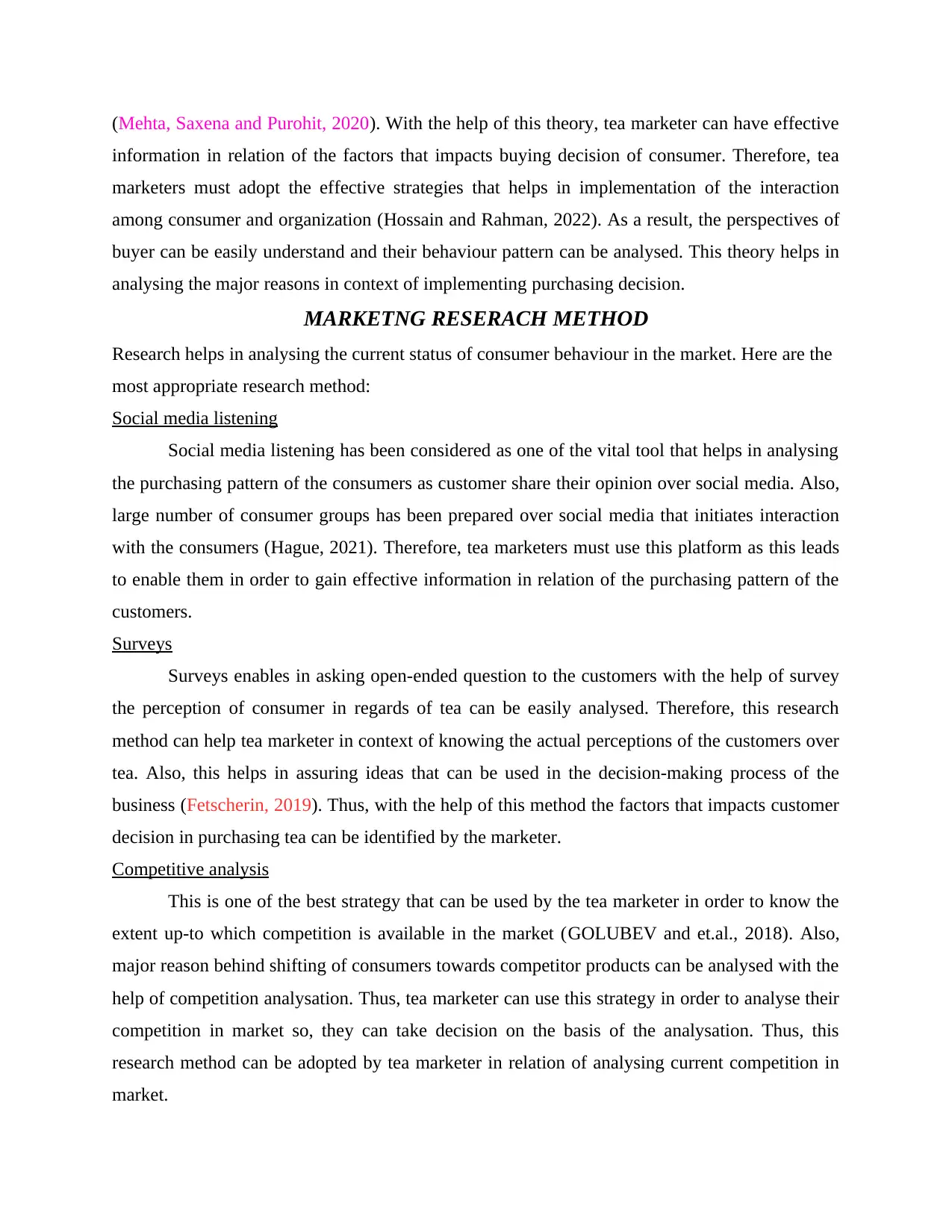
(Mehta, Saxena and Purohit, 2020). With the help of this theory, tea marketer can have effective
information in relation of the factors that impacts buying decision of consumer. Therefore, tea
marketers must adopt the effective strategies that helps in implementation of the interaction
among consumer and organization (Hossain and Rahman, 2022). As a result, the perspectives of
buyer can be easily understand and their behaviour pattern can be analysed. This theory helps in
analysing the major reasons in context of implementing purchasing decision.
MARKETNG RESERACH METHOD
Research helps in analysing the current status of consumer behaviour in the market. Here are the
most appropriate research method:
Social media listening
Social media listening has been considered as one of the vital tool that helps in analysing
the purchasing pattern of the consumers as customer share their opinion over social media. Also,
large number of consumer groups has been prepared over social media that initiates interaction
with the consumers (Hague, 2021). Therefore, tea marketers must use this platform as this leads
to enable them in order to gain effective information in relation of the purchasing pattern of the
customers.
Surveys
Surveys enables in asking open-ended question to the customers with the help of survey
the perception of consumer in regards of tea can be easily analysed. Therefore, this research
method can help tea marketer in context of knowing the actual perceptions of the customers over
tea. Also, this helps in assuring ideas that can be used in the decision-making process of the
business (Fetscherin, 2019). Thus, with the help of this method the factors that impacts customer
decision in purchasing tea can be identified by the marketer.
Competitive analysis
This is one of the best strategy that can be used by the tea marketer in order to know the
extent up-to which competition is available in the market (GOLUBEV and et.al., 2018). Also,
major reason behind shifting of consumers towards competitor products can be analysed with the
help of competition analysation. Thus, tea marketer can use this strategy in order to analyse their
competition in market so, they can take decision on the basis of the analysation. Thus, this
research method can be adopted by tea marketer in relation of analysing current competition in
market.
information in relation of the factors that impacts buying decision of consumer. Therefore, tea
marketers must adopt the effective strategies that helps in implementation of the interaction
among consumer and organization (Hossain and Rahman, 2022). As a result, the perspectives of
buyer can be easily understand and their behaviour pattern can be analysed. This theory helps in
analysing the major reasons in context of implementing purchasing decision.
MARKETNG RESERACH METHOD
Research helps in analysing the current status of consumer behaviour in the market. Here are the
most appropriate research method:
Social media listening
Social media listening has been considered as one of the vital tool that helps in analysing
the purchasing pattern of the consumers as customer share their opinion over social media. Also,
large number of consumer groups has been prepared over social media that initiates interaction
with the consumers (Hague, 2021). Therefore, tea marketers must use this platform as this leads
to enable them in order to gain effective information in relation of the purchasing pattern of the
customers.
Surveys
Surveys enables in asking open-ended question to the customers with the help of survey
the perception of consumer in regards of tea can be easily analysed. Therefore, this research
method can help tea marketer in context of knowing the actual perceptions of the customers over
tea. Also, this helps in assuring ideas that can be used in the decision-making process of the
business (Fetscherin, 2019). Thus, with the help of this method the factors that impacts customer
decision in purchasing tea can be identified by the marketer.
Competitive analysis
This is one of the best strategy that can be used by the tea marketer in order to know the
extent up-to which competition is available in the market (GOLUBEV and et.al., 2018). Also,
major reason behind shifting of consumers towards competitor products can be analysed with the
help of competition analysation. Thus, tea marketer can use this strategy in order to analyse their
competition in market so, they can take decision on the basis of the analysation. Thus, this
research method can be adopted by tea marketer in relation of analysing current competition in
market.
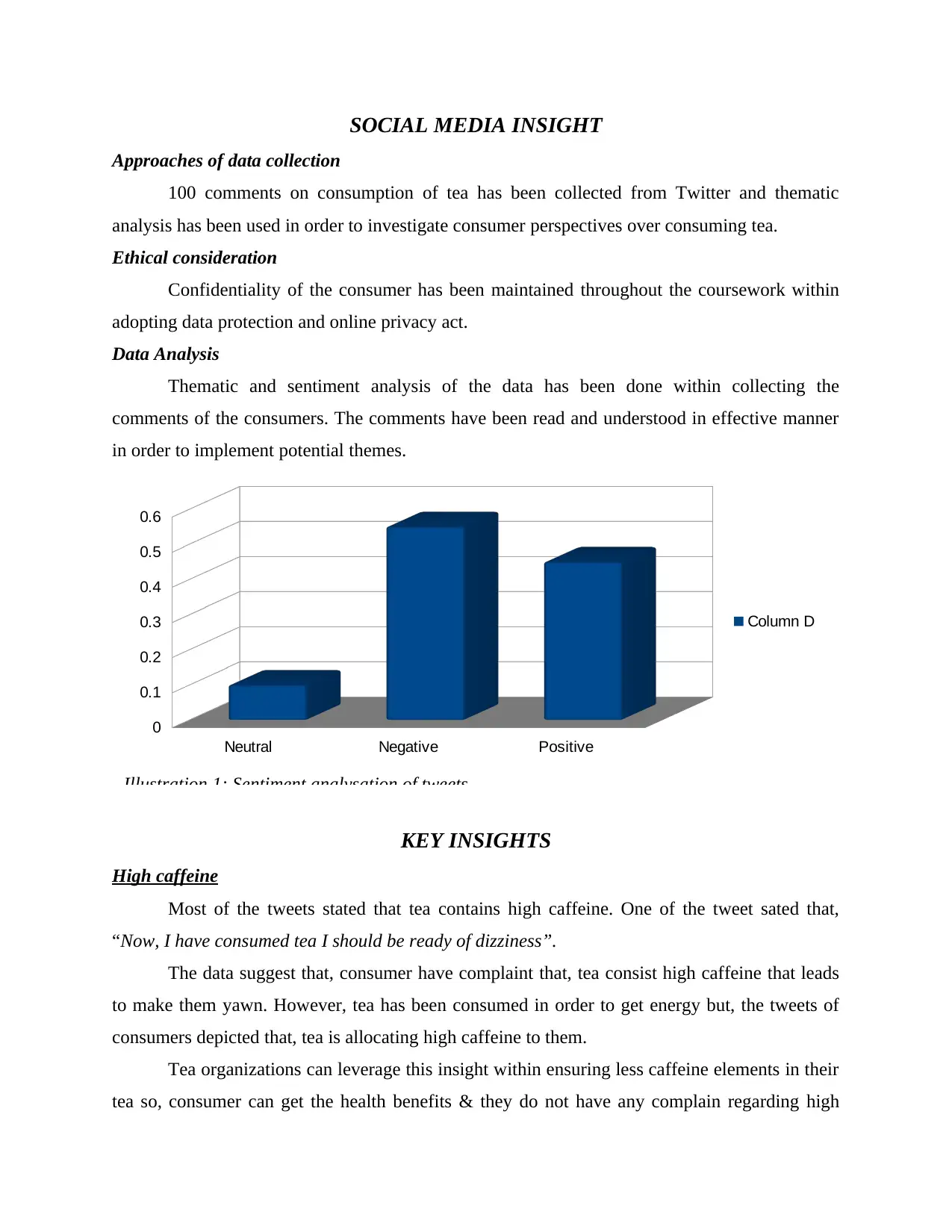
SOCIAL MEDIA INSIGHT
Approaches of data collection
100 comments on consumption of tea has been collected from Twitter and thematic
analysis has been used in order to investigate consumer perspectives over consuming tea.
Ethical consideration
Confidentiality of the consumer has been maintained throughout the coursework within
adopting data protection and online privacy act.
Data Analysis
Thematic and sentiment analysis of the data has been done within collecting the
comments of the consumers. The comments have been read and understood in effective manner
in order to implement potential themes.
KEY INSIGHTS
High caffeine
Most of the tweets stated that tea contains high caffeine. One of the tweet sated that,
“Now, I have consumed tea I should be ready of dizziness”.
The data suggest that, consumer have complaint that, tea consist high caffeine that leads
to make them yawn. However, tea has been consumed in order to get energy but, the tweets of
consumers depicted that, tea is allocating high caffeine to them.
Tea organizations can leverage this insight within ensuring less caffeine elements in their
tea so, consumer can get the health benefits & they do not have any complain regarding high
Neutral Negative Positive
0
0.1
0.2
0.3
0.4
0.5
0.6
Column D
Illustration 1: Sentiment analysation of tweets
Approaches of data collection
100 comments on consumption of tea has been collected from Twitter and thematic
analysis has been used in order to investigate consumer perspectives over consuming tea.
Ethical consideration
Confidentiality of the consumer has been maintained throughout the coursework within
adopting data protection and online privacy act.
Data Analysis
Thematic and sentiment analysis of the data has been done within collecting the
comments of the consumers. The comments have been read and understood in effective manner
in order to implement potential themes.
KEY INSIGHTS
High caffeine
Most of the tweets stated that tea contains high caffeine. One of the tweet sated that,
“Now, I have consumed tea I should be ready of dizziness”.
The data suggest that, consumer have complaint that, tea consist high caffeine that leads
to make them yawn. However, tea has been consumed in order to get energy but, the tweets of
consumers depicted that, tea is allocating high caffeine to them.
Tea organizations can leverage this insight within ensuring less caffeine elements in their
tea so, consumer can get the health benefits & they do not have any complain regarding high
Neutral Negative Positive
0
0.1
0.2
0.3
0.4
0.5
0.6
Column D
Illustration 1: Sentiment analysation of tweets
Paraphrase This Document
Need a fresh take? Get an instant paraphrase of this document with our AI Paraphraser
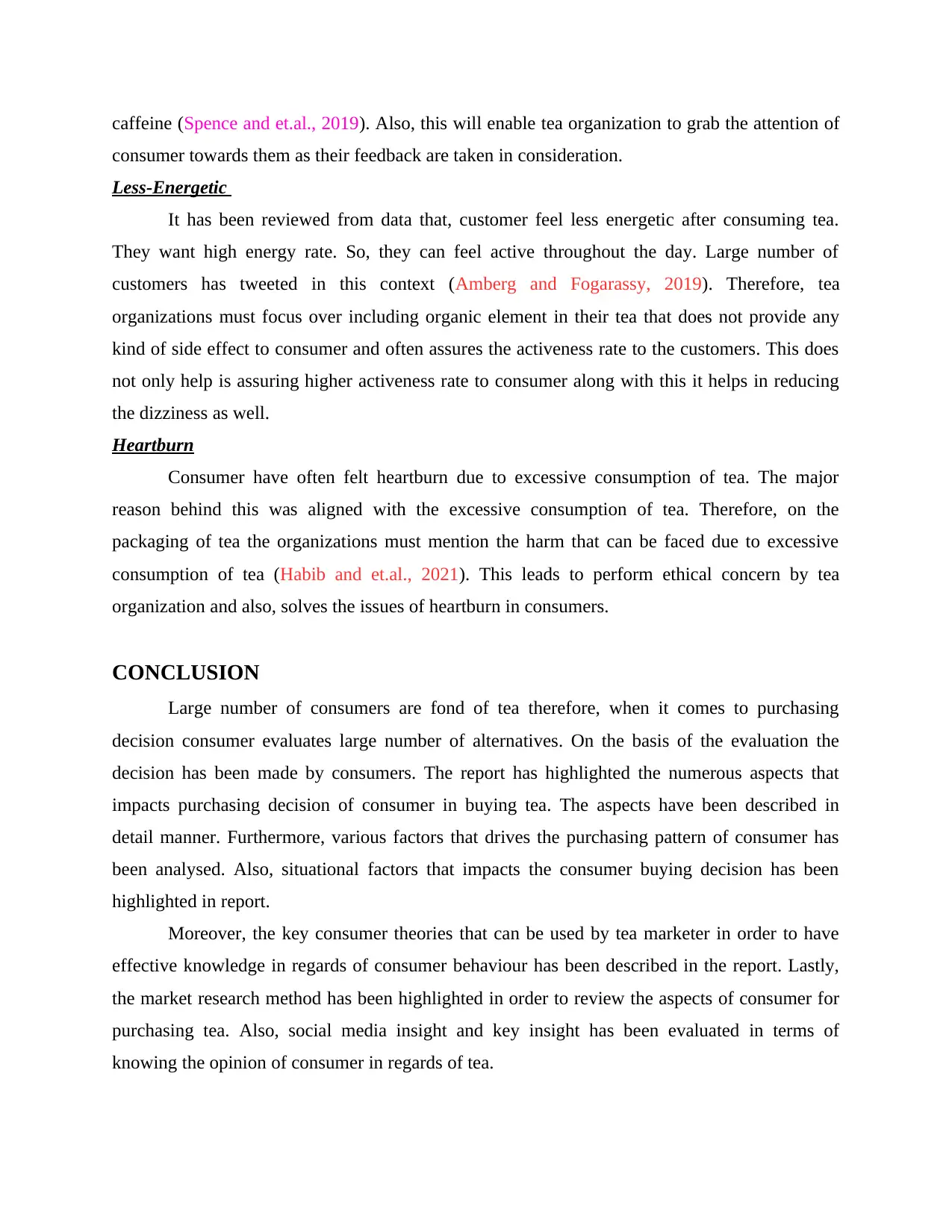
caffeine (Spence and et.al., 2019). Also, this will enable tea organization to grab the attention of
consumer towards them as their feedback are taken in consideration.
Less-Energetic
It has been reviewed from data that, customer feel less energetic after consuming tea.
They want high energy rate. So, they can feel active throughout the day. Large number of
customers has tweeted in this context (Amberg and Fogarassy, 2019). Therefore, tea
organizations must focus over including organic element in their tea that does not provide any
kind of side effect to consumer and often assures the activeness rate to the customers. This does
not only help is assuring higher activeness rate to consumer along with this it helps in reducing
the dizziness as well.
Heartburn
Consumer have often felt heartburn due to excessive consumption of tea. The major
reason behind this was aligned with the excessive consumption of tea. Therefore, on the
packaging of tea the organizations must mention the harm that can be faced due to excessive
consumption of tea (Habib and et.al., 2021). This leads to perform ethical concern by tea
organization and also, solves the issues of heartburn in consumers.
CONCLUSION
Large number of consumers are fond of tea therefore, when it comes to purchasing
decision consumer evaluates large number of alternatives. On the basis of the evaluation the
decision has been made by consumers. The report has highlighted the numerous aspects that
impacts purchasing decision of consumer in buying tea. The aspects have been described in
detail manner. Furthermore, various factors that drives the purchasing pattern of consumer has
been analysed. Also, situational factors that impacts the consumer buying decision has been
highlighted in report.
Moreover, the key consumer theories that can be used by tea marketer in order to have
effective knowledge in regards of consumer behaviour has been described in the report. Lastly,
the market research method has been highlighted in order to review the aspects of consumer for
purchasing tea. Also, social media insight and key insight has been evaluated in terms of
knowing the opinion of consumer in regards of tea.
consumer towards them as their feedback are taken in consideration.
Less-Energetic
It has been reviewed from data that, customer feel less energetic after consuming tea.
They want high energy rate. So, they can feel active throughout the day. Large number of
customers has tweeted in this context (Amberg and Fogarassy, 2019). Therefore, tea
organizations must focus over including organic element in their tea that does not provide any
kind of side effect to consumer and often assures the activeness rate to the customers. This does
not only help is assuring higher activeness rate to consumer along with this it helps in reducing
the dizziness as well.
Heartburn
Consumer have often felt heartburn due to excessive consumption of tea. The major
reason behind this was aligned with the excessive consumption of tea. Therefore, on the
packaging of tea the organizations must mention the harm that can be faced due to excessive
consumption of tea (Habib and et.al., 2021). This leads to perform ethical concern by tea
organization and also, solves the issues of heartburn in consumers.
CONCLUSION
Large number of consumers are fond of tea therefore, when it comes to purchasing
decision consumer evaluates large number of alternatives. On the basis of the evaluation the
decision has been made by consumers. The report has highlighted the numerous aspects that
impacts purchasing decision of consumer in buying tea. The aspects have been described in
detail manner. Furthermore, various factors that drives the purchasing pattern of consumer has
been analysed. Also, situational factors that impacts the consumer buying decision has been
highlighted in report.
Moreover, the key consumer theories that can be used by tea marketer in order to have
effective knowledge in regards of consumer behaviour has been described in the report. Lastly,
the market research method has been highlighted in order to review the aspects of consumer for
purchasing tea. Also, social media insight and key insight has been evaluated in terms of
knowing the opinion of consumer in regards of tea.
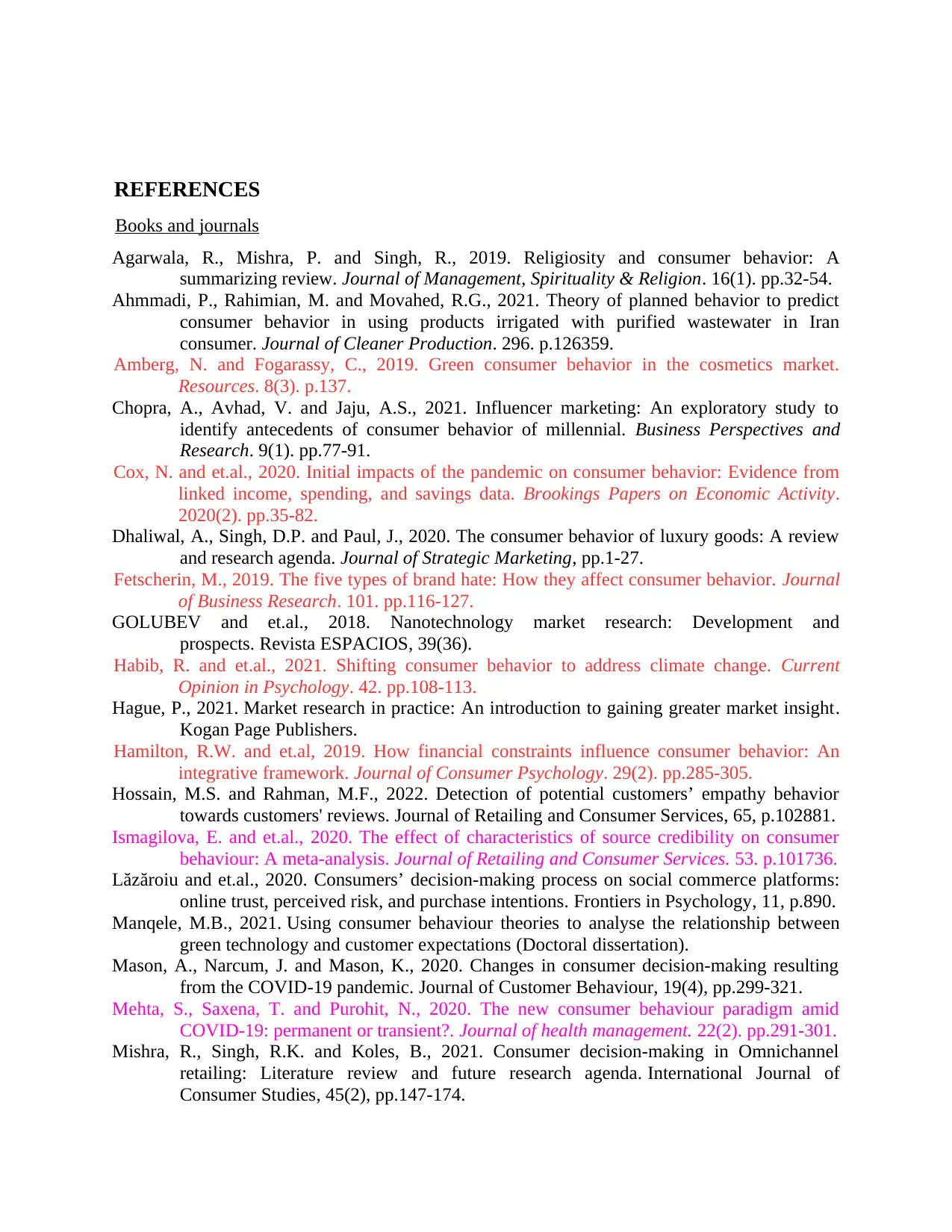
REFERENCES
Books and journals
Agarwala, R., Mishra, P. and Singh, R., 2019. Religiosity and consumer behavior: A
summarizing review. Journal of Management, Spirituality & Religion. 16(1). pp.32-54.
Ahmmadi, P., Rahimian, M. and Movahed, R.G., 2021. Theory of planned behavior to predict
consumer behavior in using products irrigated with purified wastewater in Iran
consumer. Journal of Cleaner Production. 296. p.126359.
Amberg, N. and Fogarassy, C., 2019. Green consumer behavior in the cosmetics market.
Resources. 8(3). p.137.
Chopra, A., Avhad, V. and Jaju, A.S., 2021. Influencer marketing: An exploratory study to
identify antecedents of consumer behavior of millennial. Business Perspectives and
Research. 9(1). pp.77-91.
Cox, N. and et.al., 2020. Initial impacts of the pandemic on consumer behavior: Evidence from
linked income, spending, and savings data. Brookings Papers on Economic Activity.
2020(2). pp.35-82.
Dhaliwal, A., Singh, D.P. and Paul, J., 2020. The consumer behavior of luxury goods: A review
and research agenda. Journal of Strategic Marketing, pp.1-27.
Fetscherin, M., 2019. The five types of brand hate: How they affect consumer behavior. Journal
of Business Research. 101. pp.116-127.
GOLUBEV and et.al., 2018. Nanotechnology market research: Development and
prospects. Revista ESPACIOS, 39(36).
Habib, R. and et.al., 2021. Shifting consumer behavior to address climate change. Current
Opinion in Psychology. 42. pp.108-113.
Hague, P., 2021. Market research in practice: An introduction to gaining greater market insight.
Kogan Page Publishers.
Hamilton, R.W. and et.al, 2019. How financial constraints influence consumer behavior: An
integrative framework. Journal of Consumer Psychology. 29(2). pp.285-305.
Hossain, M.S. and Rahman, M.F., 2022. Detection of potential customers’ empathy behavior
towards customers' reviews. Journal of Retailing and Consumer Services, 65, p.102881.
Ismagilova, E. and et.al., 2020. The effect of characteristics of source credibility on consumer
behaviour: A meta-analysis. Journal of Retailing and Consumer Services. 53. p.101736.
Lăzăroiu and et.al., 2020. Consumers’ decision-making process on social commerce platforms:
online trust, perceived risk, and purchase intentions. Frontiers in Psychology, 11, p.890.
Manqele, M.B., 2021. Using consumer behaviour theories to analyse the relationship between
green technology and customer expectations (Doctoral dissertation).
Mason, A., Narcum, J. and Mason, K., 2020. Changes in consumer decision-making resulting
from the COVID-19 pandemic. Journal of Customer Behaviour, 19(4), pp.299-321.
Mehta, S., Saxena, T. and Purohit, N., 2020. The new consumer behaviour paradigm amid
COVID-19: permanent or transient?. Journal of health management. 22(2). pp.291-301.
Mishra, R., Singh, R.K. and Koles, B., 2021. Consumer decision‐making in Omnichannel
retailing: Literature review and future research agenda. International Journal of
Consumer Studies, 45(2), pp.147-174.
Books and journals
Agarwala, R., Mishra, P. and Singh, R., 2019. Religiosity and consumer behavior: A
summarizing review. Journal of Management, Spirituality & Religion. 16(1). pp.32-54.
Ahmmadi, P., Rahimian, M. and Movahed, R.G., 2021. Theory of planned behavior to predict
consumer behavior in using products irrigated with purified wastewater in Iran
consumer. Journal of Cleaner Production. 296. p.126359.
Amberg, N. and Fogarassy, C., 2019. Green consumer behavior in the cosmetics market.
Resources. 8(3). p.137.
Chopra, A., Avhad, V. and Jaju, A.S., 2021. Influencer marketing: An exploratory study to
identify antecedents of consumer behavior of millennial. Business Perspectives and
Research. 9(1). pp.77-91.
Cox, N. and et.al., 2020. Initial impacts of the pandemic on consumer behavior: Evidence from
linked income, spending, and savings data. Brookings Papers on Economic Activity.
2020(2). pp.35-82.
Dhaliwal, A., Singh, D.P. and Paul, J., 2020. The consumer behavior of luxury goods: A review
and research agenda. Journal of Strategic Marketing, pp.1-27.
Fetscherin, M., 2019. The five types of brand hate: How they affect consumer behavior. Journal
of Business Research. 101. pp.116-127.
GOLUBEV and et.al., 2018. Nanotechnology market research: Development and
prospects. Revista ESPACIOS, 39(36).
Habib, R. and et.al., 2021. Shifting consumer behavior to address climate change. Current
Opinion in Psychology. 42. pp.108-113.
Hague, P., 2021. Market research in practice: An introduction to gaining greater market insight.
Kogan Page Publishers.
Hamilton, R.W. and et.al, 2019. How financial constraints influence consumer behavior: An
integrative framework. Journal of Consumer Psychology. 29(2). pp.285-305.
Hossain, M.S. and Rahman, M.F., 2022. Detection of potential customers’ empathy behavior
towards customers' reviews. Journal of Retailing and Consumer Services, 65, p.102881.
Ismagilova, E. and et.al., 2020. The effect of characteristics of source credibility on consumer
behaviour: A meta-analysis. Journal of Retailing and Consumer Services. 53. p.101736.
Lăzăroiu and et.al., 2020. Consumers’ decision-making process on social commerce platforms:
online trust, perceived risk, and purchase intentions. Frontiers in Psychology, 11, p.890.
Manqele, M.B., 2021. Using consumer behaviour theories to analyse the relationship between
green technology and customer expectations (Doctoral dissertation).
Mason, A., Narcum, J. and Mason, K., 2020. Changes in consumer decision-making resulting
from the COVID-19 pandemic. Journal of Customer Behaviour, 19(4), pp.299-321.
Mehta, S., Saxena, T. and Purohit, N., 2020. The new consumer behaviour paradigm amid
COVID-19: permanent or transient?. Journal of health management. 22(2). pp.291-301.
Mishra, R., Singh, R.K. and Koles, B., 2021. Consumer decision‐making in Omnichannel
retailing: Literature review and future research agenda. International Journal of
Consumer Studies, 45(2), pp.147-174.
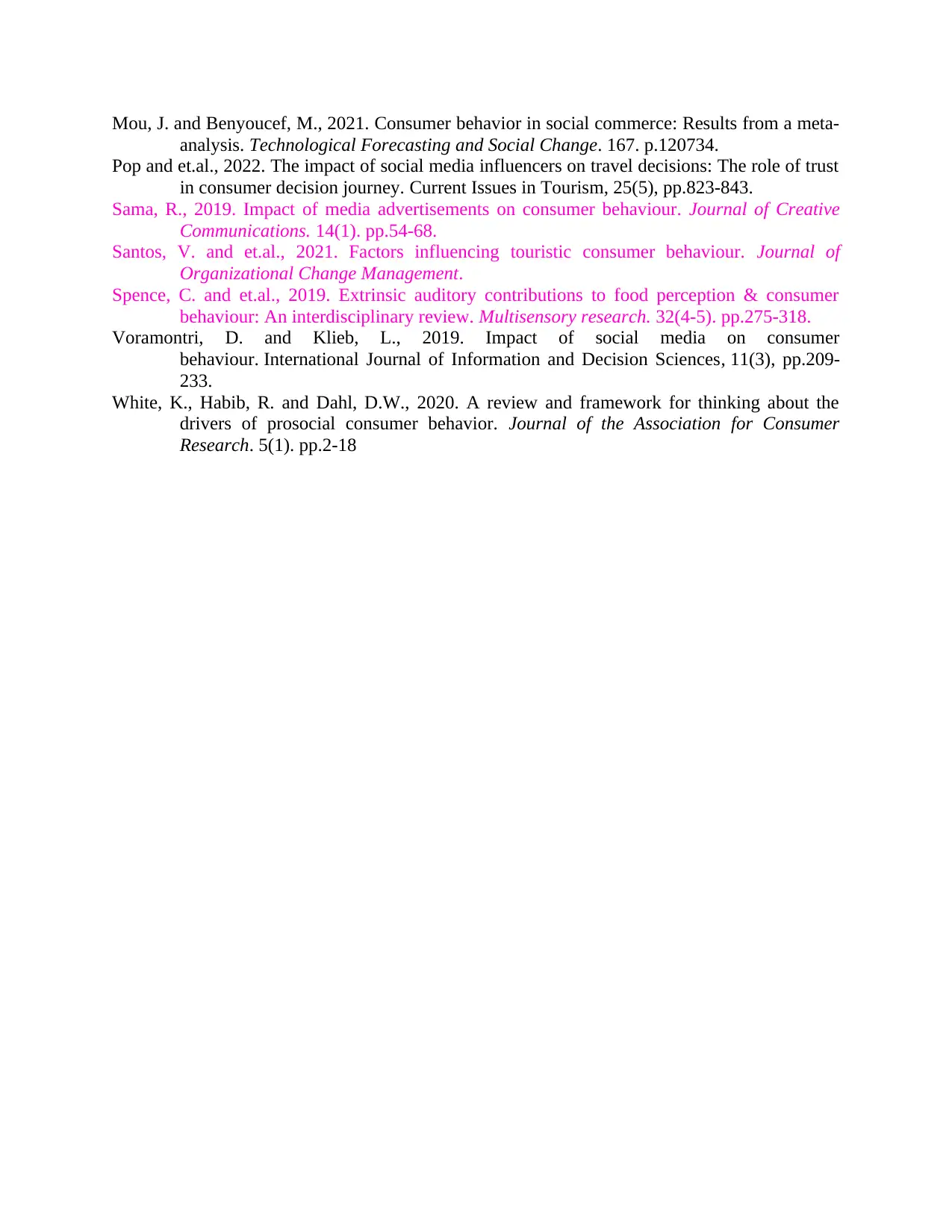
Mou, J. and Benyoucef, M., 2021. Consumer behavior in social commerce: Results from a meta-
analysis. Technological Forecasting and Social Change. 167. p.120734.
Pop and et.al., 2022. The impact of social media influencers on travel decisions: The role of trust
in consumer decision journey. Current Issues in Tourism, 25(5), pp.823-843.
Sama, R., 2019. Impact of media advertisements on consumer behaviour. Journal of Creative
Communications. 14(1). pp.54-68.
Santos, V. and et.al., 2021. Factors influencing touristic consumer behaviour. Journal of
Organizational Change Management.
Spence, C. and et.al., 2019. Extrinsic auditory contributions to food perception & consumer
behaviour: An interdisciplinary review. Multisensory research. 32(4-5). pp.275-318.
Voramontri, D. and Klieb, L., 2019. Impact of social media on consumer
behaviour. International Journal of Information and Decision Sciences, 11(3), pp.209-
233.
White, K., Habib, R. and Dahl, D.W., 2020. A review and framework for thinking about the
drivers of prosocial consumer behavior. Journal of the Association for Consumer
Research. 5(1). pp.2-18
analysis. Technological Forecasting and Social Change. 167. p.120734.
Pop and et.al., 2022. The impact of social media influencers on travel decisions: The role of trust
in consumer decision journey. Current Issues in Tourism, 25(5), pp.823-843.
Sama, R., 2019. Impact of media advertisements on consumer behaviour. Journal of Creative
Communications. 14(1). pp.54-68.
Santos, V. and et.al., 2021. Factors influencing touristic consumer behaviour. Journal of
Organizational Change Management.
Spence, C. and et.al., 2019. Extrinsic auditory contributions to food perception & consumer
behaviour: An interdisciplinary review. Multisensory research. 32(4-5). pp.275-318.
Voramontri, D. and Klieb, L., 2019. Impact of social media on consumer
behaviour. International Journal of Information and Decision Sciences, 11(3), pp.209-
233.
White, K., Habib, R. and Dahl, D.W., 2020. A review and framework for thinking about the
drivers of prosocial consumer behavior. Journal of the Association for Consumer
Research. 5(1). pp.2-18
1 out of 16
Related Documents
Your All-in-One AI-Powered Toolkit for Academic Success.
+13062052269
info@desklib.com
Available 24*7 on WhatsApp / Email
![[object Object]](/_next/static/media/star-bottom.7253800d.svg)
Unlock your academic potential
© 2024 | Zucol Services PVT LTD | All rights reserved.




